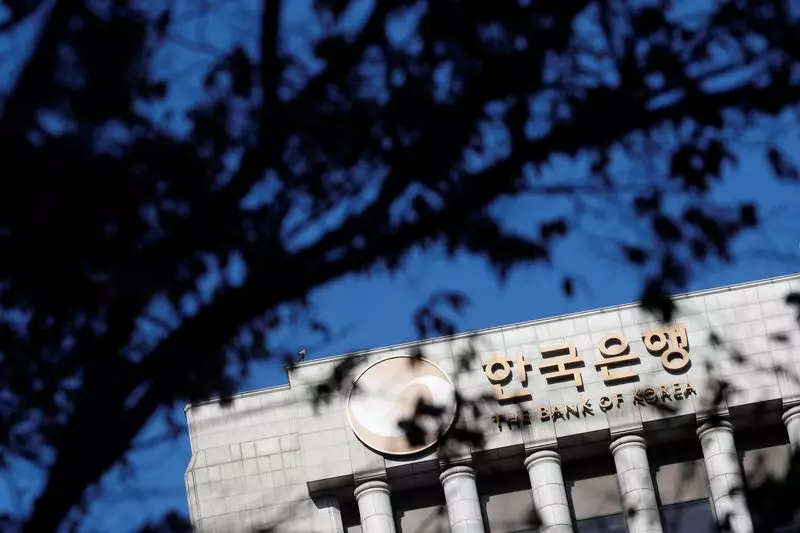In a move that has raised eyebrows, South Korea’s central bank has enacted an unexpected interest rate cut, marking a pivotal moment in economic policymaking amid growing uncertainty. With the electoral re-emergence of Donald Trump as president, South Korea’s economic oversight is compelled to adapt to international dynamics that threaten its trade-driven economy. The decisions made by the Bank of Korea (BOK) during its recent meeting illustrate a proactive strategy in the face of fluctuating global trade relationships and dim domestic economic indicators.
In an unprecedented step, the BOK lowered the benchmark interest rate to 3.00%, following consecutive meetings with a singular goal: to stimulate a languishing economy. Only a minority of economists had anticipated this outcome, revealing a disconnect between market perception and the central bank’s evaluation of existing economic conditions. The decisive vote within the seven-member board, which saw a majority favoring the rate cut, signifies a broader consensus on the urgency for action in stabilizing economic growth.
Governor Rhee Chang-yong’s remarks during the press conference paint a vivid picture of a central bank ready to confront imminent challenges. By acknowledging that certain board members are poised to consider additional rate cuts, the BOK is signaling that its vigilance over economic conditions will remain intense in the forthcoming months. This move also highlights a strategy focused on countering intensifying competition in exports—particularly detrimental given South Korea’s reliance on international trade as a fundamental growth engine.
With recent electoral developments in the United States, South Korea’s policymakers are on alert regarding the potential for increased tariffs between the two nations. The prospect of former President Trump reinstating punitive trade measures poses substantial risks to South Korean exports, which are critical to the country’s GDP. The economy narrowly avoided a technical recession, with a mere 0.1% growth, illustrating the precariousness of its position. The government’s considerations around a supplementary budget signal a recognition of the declining momentum in private consumption and the overarching necessity for strategic reinvestment.
Moreover, the confluence of these domestic economic challenges with global trade uncertainties emphasizes the delicate balance that the BOK must maintain. As the fourth-largest economy in Asia, stability in South Korea’s trade relationships is essential for ensuring sustainable growth, and the looming threat of increased tariffs—especially with pivotal partners like China—exacerbates these concerns.
In response to both economic pressures and external trade risks, the South Korean government is directing its efforts toward bolstering critical sectors, particularly focusing on the chip industry, which serves as a cornerstone of its economic prowess. The announcement of support plans for local chipmakers demonstrates a strategic pivot aimed at preemptively mitigating threats posed by potentially hostile trade policies from the anticipated Trump administration.
Economists have noted the importance of this sector and its influence on global technology supply chains, indicating that safeguarding it is tantamount to preserving overall economic health. Ahn Jae-kyun, an analyst at Shinhan Securities, remarked on the likelihood of further rate cuts, suggesting that the central bank’s measures are a necessary response to maintain the competitiveness of South Korean industries amidst shifting global dynamics.
In the grander scheme of things, the BOK has downgraded its economic projections for growth and inflation, highlighting a need for realistic expectations moving forward. The revised growth forecast for 2024, now at 2.2% down from 2.4%, reflects uncertainty around both domestic spending and the global trade environment. Similarly, inflation expectations have been adjusted downward to 2.3% for the year, hinting at a controlled economic landscape.
In a critical reflection, the weakened South Korean won also raises questions about the BOK’s strategies for currency stabilization in coordination with the government. The performance of the won as Asia’s most underperforming currency of the year underscores the importance of a cohesive policy response to not only bolster economic confidence but also enhance global standing.
South Korea’s recent interest rate cut is not simply an isolated economic maneuver; it underscores a broader strategy aimed at navigating prevailing uncertainties. As the government focuses on key industries and adapts to fluctuating global trade dynamics, the effectiveness of these measures will ultimately determine the resilience of South Korea’s economy in an increasingly precarious landscape.

